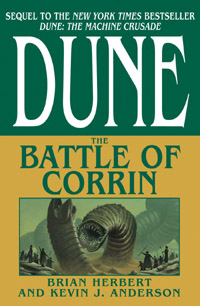
Baron Vladimir Harkonnen is a fictional character in the Dune franchise created by Frank Herbert. He is primarily featured in the 1965 novel Dune and is also a prominent character in the Prelude to Dune prequel trilogy (1999–2001) by Herbert's son Brian and Kevin J. Anderson. The character is brought back as a ghola in the Herbert/Anderson sequels which conclude the original series, Hunters of Dune (2006) and Sandworms of Dune (2007).
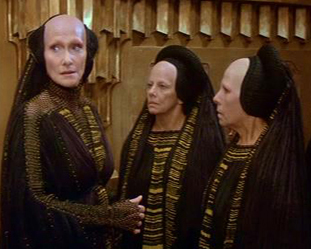
The Bene Gesserit are a group in Frank Herbert's fictional Dune universe. A powerful social, religious, and political force, the Bene Gesserit is described as an exclusive sisterhood whose members train their bodies and minds through years of physical and mental conditioning to obtain superhuman powers and abilities that seem magical to outsiders. The group seeks to acquire power and influence to direct humanity on an enlightened path, a concerted effort planned and executed over centuries.

Duncan Idaho is a fictional character in the Dune universe created by Frank Herbert. He was introduced in the first novel of the series, 1965's Dune, and became a breakout character. He was revived in 1969's Dune Messiah. He is the only character to feature in all six of Herbert's original Dune novels.

The Fremen are a group of people in the fictional Dune universe created by Frank Herbert. First appearing in the 1965 novel Dune, the Fremen inhabit the desert planet Arrakis, which is the sole known source in the universe of the all-important spice melange. Long overlooked by the rest of the Imperium and considered backward savages, in reality they are an extremely hardy people and exist in large numbers. The Fremen had come to the planet thousands of years before the events of the novel as the Zensunni Wanderers, a religious sect in retreat. As humans in extremis, over time they adapted their culture and way of life to survive and thrive in the incredibly harsh conditions of Arrakis. The Fremen are distinguished by their fierce fighting abilities and adeptness at survival in these conditions. With water being such a rare commodity on the planet, their culture revolves around its preservation and conservation. Herbert based Fremen culture, in part, on the desert-dwelling Bedouin and San People.

The Spacing Guild is an organization in Frank Herbert's science fiction Dune universe that possesses a monopoly on interstellar travel and banking. Guild Navigators use the drug melange to achieve limited prescience, a form of precognition that allows them to successfully navigate "folded space" and safely guide enormous starships called heighliners across interstellar space instantaneously.
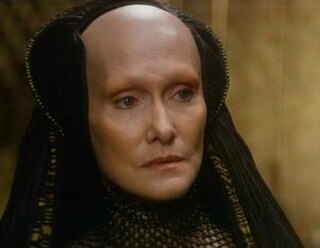
Gaius Helen Mohiam is a fictional character in the Dune universe created by Frank Herbert. She is a Bene Gesserit Reverend Mother, and initially appears in the 1963–65 novel Dune and its 1969 sequel, Dune Messiah. Mohiam also has a major role in the Prelude to Dune prequel trilogy (1999–2001) and the Caladan Trilogy (2020–2022) by Brian Herbert and Kevin J. Anderson.
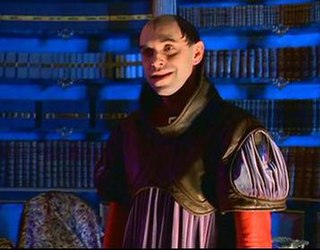
Count Hasimir Fenring is a fictional character in the Dune universe created by Frank Herbert. He is featured in the 1965 science fiction novel Dune by Frank Herbert, and is also a key character in the Prelude to Dune trilogy by Brian Herbert and Kevin J. Anderson. He later appears in the 2008 novel Paul of Dune, and the Caladan Trilogy (2020–2022).
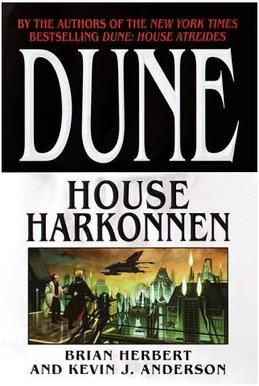
Dune: House Harkonnen is a 2000 science fiction novel by Brian Herbert and Kevin J. Anderson, set in the fictional Dune universe created by Frank Herbert. It is the second book in the Prelude to Dune prequel trilogy, which takes place before the events of Frank Herbert's celebrated 1965 novel Dune. The Prelude to Dune novels draw from notes left behind by Frank Herbert after his death.

Dune is an American science fiction media franchise that originated with the 1965 novel Dune by Frank Herbert and has continued to add new publications. Dune is frequently described as the best-selling science fiction novel in history. It won the inaugural Nebula Award for Best Novel and the Hugo Award in 1966 and was later adapted into a 1984 film, a 2000 television miniseries, and a two-part film series with the first film in 2021 and a sequel in 2024. Herbert wrote five sequels, the first two of which were concomitantly adapted as a 2003 miniseries. Dune has also inspired tabletop games and a series of video games. Since 2009, the names of planets from the Dune novels have been adopted for the real-world nomenclature of plains and other features on Saturn's moon Titan.
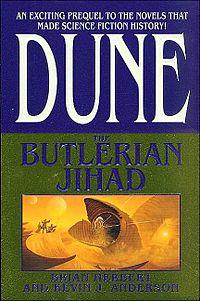
Dune: The Butlerian Jihad is a 2002 science fiction novel by Brian Herbert and Kevin J. Anderson, set in the fictional Dune universe created by Frank Herbert. It is the first book in the Legends of Dune prequel trilogy, which takes place over 10,000 years before the events of Frank Herbert's celebrated 1965 novel Dune. The series chronicles the fictional Butlerian Jihad, a crusade by the last free humans in the universe against the thinking machines, a violent and dominating force led by the sentient computer Omnius.

Dune: The Machine Crusade is a 2003 science fiction novel by Brian Herbert and Kevin J. Anderson, set in the fictional Dune universe created by Frank Herbert. It is the second book in the Legends of Dune prequel trilogy, which takes place over 10,000 years before the events of Frank Herbert's celebrated 1965 novel Dune. The series chronicles the fictional Butlerian Jihad, a crusade by the last free humans in the universe against the thinking machines, a violent and dominating force led by the sentient computer mind Omnius.

Hunters of Dune is the first of two books written by Brian Herbert and Kevin J. Anderson to conclude Frank Herbert's original Dune series of science fiction novels.

Sandworms of Dune is a science fiction novel by American writers Brian Herbert and Kevin J. Anderson, the second of two books they wrote to conclude Frank Herbert's original Dune series. It is based on notes left behind by Frank Herbert for Dune 7, his own planned seventh novel in the Dune series. The novel was released on August 7, 2007.
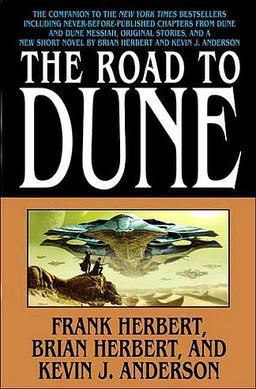
A series of Duneshort stories have been written that relate to the Dune novels by Frank Herbert, Brian Herbert and Kevin J. Anderson. Some of these stories were originally available for download from the official Dune website, released in a promotional capacity in conjunction with the Brian Herbert/Kevin J. Anderson novels. "Dune: A Whisper of Caladan Seas", "Dune: Hunting Harkonnens", "Dune: Whipping Mek", and "Dune: The Faces of a Martyr" were later published as part of the collection The Road to Dune released in September 2005. "Dune: Sea Child" was published in Elemental, a 2006 benefit anthology for children who survived the 2004 Indian Ocean tsunami, and was later made available as part of the paperback edition of The Road to Dune. "Dune: Treasure in the Sand" was published online in 2006 at Jim Baen's Universe, and was later made available as part of the paperback edition of Hunters of Dune. "Dune: Wedding Silk" was released June 12, 2011 in the Dune e-book short story collection Tales of Dune, which also included previously published stories "Dune: Sea Child" and "Dune: Treasure in the Sand." "Dune: Red Plague" was released on November 1, 2016, followed by "Dune: The Waters of Kanly" in October 17, 2017. "Blood of the Sardaukar" was released in March 2019. "Dune: The Edge of a Crysknife" and "Dune: Imperial Court" released on June 28, 2022 in the novella collection Sands of Dune, which also included "The Waters of Kanly" and "Blood of the Sardaukar", which had previously only been published in other short story anthologies.

Sisterhood of Dune is a 2012 science fiction novel by Brian Herbert and Kevin J. Anderson, set in the Dune universe created by Frank Herbert. It is the first book in their Great Schools of Dune prequel trilogy, which itself is a sequel to their Legends of Dune trilogy. The book is set eighty years after the events of 2004's Dune: The Battle of Corrin, in which the human military finally defeat the thinking machine armies of Omnius. Now, the fledgling Bene Gesserit, Mentat and Suk Schools, as well as the Spacing Guild, are threatened by the independent anti-technology forces gaining power in the aftermath of the Butlerian Jihad. The Great Schools of Dune trilogy, first mentioned by Anderson in a 2010 blog post, will chronicle the early years of these organizations, which figure prominently in the original Dune novels.
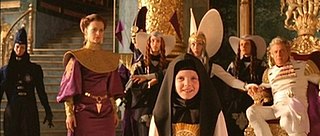
Multiple organizations of the Dune universe dominate the political, religious, and social arena of the setting of Frank Herbert's Dune series of science fiction novels, and derivative works. Set tens of thousands of years in the future, the saga chronicles a civilization which has banned computers but has also developed advanced technology and mental and physical abilities through physical training, eugenics and the use of the drug melange. Specialized groups of individuals have aligned themselves in organizations focusing on specific abilities, technology and goals. Herbert's concepts of human evolution and technology have been analyzed and deconstructed in at least one book, The Science of Dune (2008). His originating 1965 novel Dune is popularly considered one of the greatest science fiction novels of all time, and is frequently cited as the best-selling science fiction novel in history. Dune and its five sequels by Herbert explore the complex and multilayered interactions of politics, religion, ecology and technology, among other themes.
We've a three-point civilization: the Imperial Household balanced against the Federated Great Houses of the Landsraad, and between them, the Guild with its damnable monopoly on interstellar transport.
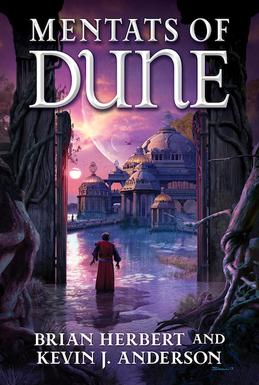
Mentats of Dune is a 2014 science fiction novel by Brian Herbert and Kevin J. Anderson, set in the Dune universe created by Frank Herbert. It is the second book in their Great Schools of Dune prequel trilogy, which itself is a sequel to their Legends of Dune trilogy. Set nearly a century after the events of 2004's Dune: The Battle of Corrin, the novel continues to chronicle the beginnings of the Bene Gesserit, Mentat and Suk Schools, as well as the Spacing Guild, all of whom are threatened by the independent anti-technology forces gaining power in the aftermath of the Butlerian Jihad. The Great Schools of Dune trilogy, first mentioned by Anderson in a 2010 blog post, chronicles the early years of these organizations, which figure prominently in the original Dune novels.

The Dune prequel series is a sequence of novel trilogies written by Brian Herbert and Kevin J. Anderson. Set in the Dune universe created by Frank Herbert, the novels take place in various time periods before and in between Herbert's original six novels, which began with 1965's Dune. In 1997, Bantam Books made a $3 million deal with the authors for three Dune prequel novels, partially based upon notes left behind by Frank Herbert, that would come to be known as the Prelude to Dune trilogy. Starting with 1999's Dune: House Atreides, the duo have published 15 Dune prequel novels to date.
